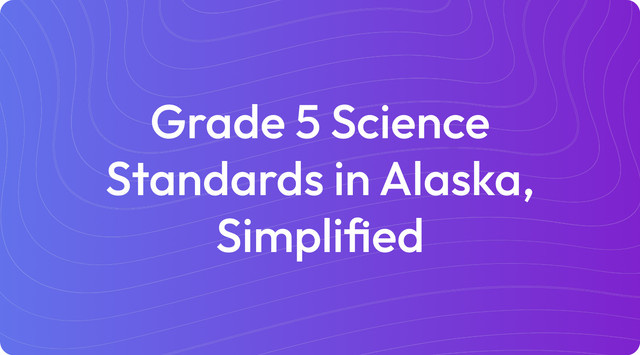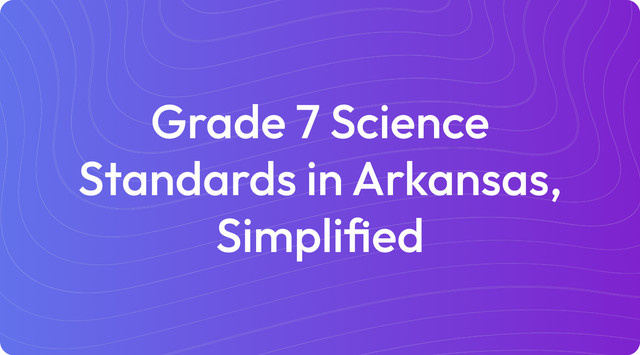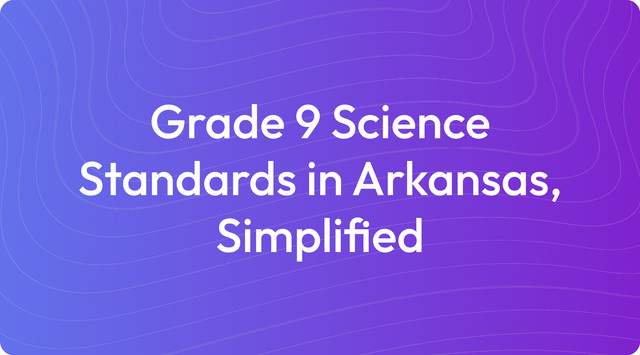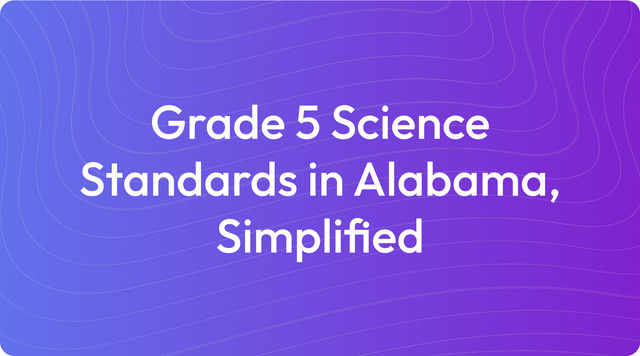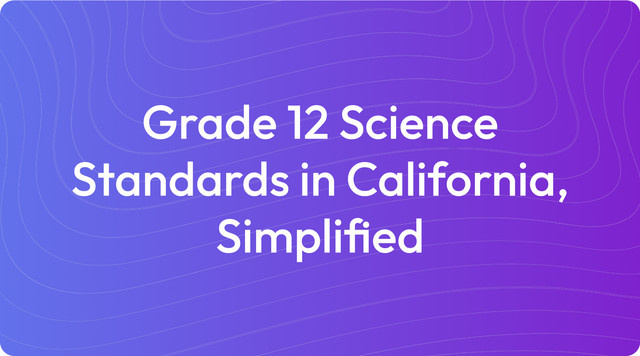Grade 6 Science Standards in Arkansas, Simplified
Grade 6 science in Arkansas covers atoms, energy, ecosystems, and Earth systems. Quick standards breakdown—read on TeachShare!
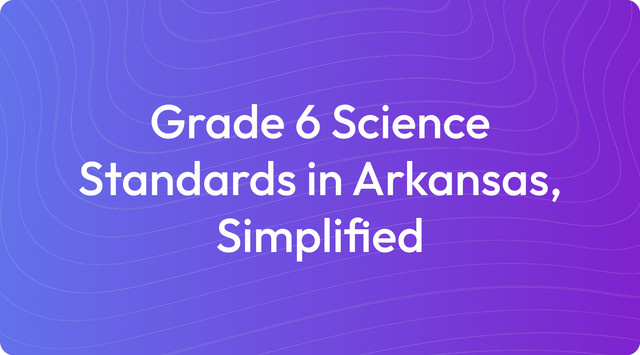
We understand that aligning your curriculum with state standards is a foundational part of your work. It requires careful planning to ensure your students meet their learning goals. Our goal is to provide resources that make this process clearer and more manageable for you and your team.
Education standards are learning goals that outline what students should know and be able to do at each grade level. For teachers, they provide clear benchmarks for instruction without dictating specific teaching methods. For example, the Grade 6 Science Standards in Arkansas are organized into domains like Physical Science and Life Science, with specific expectations such as developing models to describe atomic composition.
What Are Grade 6 Science Standards in Arkansas?
The Grade 6 Science Standards in Arkansas emphasize three-dimensional learning across several key domains. This approach integrates practices, core ideas, and crosscutting concepts to provide a rich, interconnected science education. Below is a detailed breakdown of the standards for Physical Science, Life Science, Earth and Space Science, and Engineering Design.
Physical Science (PS)
MS-PS1-1: Develop and use models to describe the atomic composition of simple molecules and extended structures.
MS-PS1-2: Analyze and interpret data on the properties of substances before and after they interact to determine if a chemical reaction occurred.
MS-PS1-5: Explain how mass is conserved in a chemical reaction using molecular models.
MS-PS3-4: Plan and conduct investigations to demonstrate energy transfer by heat, light, sound, or electric currents.
Life Science (LS)
MS-LS1-1: Use models to describe how cells are the basic unit of life and perform functions necessary for survival.
MS-LS1-3: Describe how cells and systems work together to support life (e.g., respiration, digestion, circulation).
MS-LS1-5: Construct explanations of how environmental and genetic factors influence the growth of organisms.
MS-LS2-3: Develop a model to explain the cycling of matter and flow of energy in ecosystems.
Earth and Space Science (ESS)
MS-ESS1-1: Develop and use models to describe patterns of the apparent motion of the sun, moon, and stars.
MS-ESS2-1: Describe and model the interactions of Earth’s systems (geosphere, biosphere, hydrosphere, atmosphere).
MS-ESS3-1: Explain how human activities affect Earth’s resources and environment.
Engineering Design (ETS)
MS-ETS1-1: Define a problem that can be solved through engineering.
MS-ETS1-2: Design and test solutions to solve real-world problems.
The framework for these standards is guided by the Next Generation Science Standards, which are foundational to curriculum development in Arkansas.
Key Tested Standards
For Grade 6 Science in Arkansas, assessments typically focus on foundational concepts and skills that are critical for progression. The standards most likely to be tested are highlighted below to help you focus your instruction:
Physical Science (PS)
MS-PS1-1: Develop models to describe the atomic composition of molecules and structures
MS-PS1-2: Analyze data to determine if a chemical reaction has occurred based on substance properties
MS-PS3-4: Investigate energy transfer through heat, light, sound, or electricity
Life Science (LS)
MS-LS1-1: Model how cells are the basic unit of life and perform necessary functions
MS-LS1-3: Describe how cells and body systems work together to support life
MS-LS2-3: Develop a model to explain matter cycling and energy flow in ecosystems
Earth and Space Science (ESS)
MS-ESS1-1: Model patterns in the apparent motion of the sun, moon, and stars
MS-ESS2-1: Describe and model interactions between Earth’s systems
MS-ESS3-1: Explain how human activities impact Earth’s resources
These standards focus on modeling, analyzing data, and understanding large systems, which are essential skills for assessment. This information is based on guidance from the Next Generation Science Standards and the Arkansas Division of Elementary and Secondary Education.
Example Learning Objectives for Unit Planning
Learning objectives translate broad standards into clear, student-friendly goals. They define what students should be able to do by the end of a lesson, helping you design focused instruction and allowing students to track their own progress.
To help with your unit planning, here are some examples for two key Grade 6 standards:
Standard: MS-PS1-2 (Analyze data to determine if a chemical reaction occurred)
I can observe changes in substances to identify signs of a chemical reaction (e.g., color change, gas production, temperature change).
I can analyze data to determine if a new substance has formed after a reaction.
I can explain how properties of substances help identify chemical reactions.
Standard: MS-LS1-1 (Cells are the basic unit of life)
I can describe how cells are the smallest unit that carries out functions for life.
I can explain the role of specific cell parts (organelles) like the nucleus or cell membrane.
I can use a model to show how cells work together to help a living organism survive.
Key Changes & Updates
The Grade 6 Science Standards in Arkansas were updated in 2015 to align with the Next Generation Science Standards (NGSS). This update marked a significant shift away from rote memorization toward a more hands-on, inquiry-based approach focused on real-world applications. The key changes introduced by this new framework include:
Three-Dimensional Learning: An integrated approach that combines what students do (practices), what they know (core ideas), and how they think (concepts).
Focus on Real-World Phenomena: Learning is anchored in observable events and questions, making science more relevant and engaging.
Performance-Based Expectations: Students demonstrate understanding by completing tasks like building models or analyzing data, rather than just memorizing facts.
Integration of Engineering Design: A new emphasis on defining problems and designing and testing solutions to solve real-world challenges.
Create with TeachShare
We know that keeping up with standards and creating fresh, effective materials is a constant challenge. Our platform is designed to help you build lessons, activities, and assessments that directly align with the Arkansas Grade 6 Science Standards, giving you more time to focus on teaching. Start creating standards-aligned instructional resources with TeachShare now.
Frequently Asked Questions
1. What are the main topics covered in Grade 6 Science?
In Grade 6 Science, students explore a variety of foundational topics. Here’s a look at what’s covered:
- Physical Science: Investigating the building blocks of matter, chemical changes, and how energy moves
- Life Science: Learning about cells, how body systems function, and the interactions within ecosystems
- Earth and Space Science: Studying patterns in space, Earth’s interconnected systems, and our effect on the environment
- Engineering Design: Applying knowledge to create and test solutions for real-world challenges
2. What is three-dimensional learning, and why is it important?
Three-dimensional learning is an approach that weaves together three key areas to create a richer educational experience. It combines:
- Science and Engineering Practices (SEPs): The "how-to" of science, where students actively investigate and model ideas
- Crosscutting Concepts (CCCs): The big ideas, like cause and effect, that connect different scientific fields
- Disciplinary Core Ideas (DCIs): The essential content knowledge in topics like matter or ecosystems
This method is valuable because it encourages students to think like scientists, solve complex problems, and see how science applies to their own lives.
3. How do these standards incorporate hands-on learning?
The standards are designed to get students actively involved in science. You'll find many opportunities for hands-on activities, such as:
- Modeling atoms and molecules
- Observing and analyzing the signs of a chemical reaction
- Investigating how different body systems cooperate
- Designing practical solutions to environmental issues
4. How are students assessed in Grade 6 Science?
Assessment in Grade 6 Science focuses on what students can do with their knowledge. Instead of just memorization, students are evaluated through methods like these:
- Performance tasks: Activities like creating a model of a food web to show their understanding of ecosystems
- Experiments: Conducting tests to see how energy is transferred through light or heat
- Data analysis: Interpreting information to find patterns, such as those in the movement of celestial bodies
5. How do these standards prepare students for later grades?
These Grade 6 standards are crucial for building a strong foundation for future science courses. They help students develop essential skills in:
- Analyzing data and constructing models
- Applying broad concepts like systems thinking and energy transfer
- Investigating real-world problems
By mastering these abilities, students are better prepared for more advanced subjects in later grades, including physics, genetics, and complex Earth systems.
Answer


